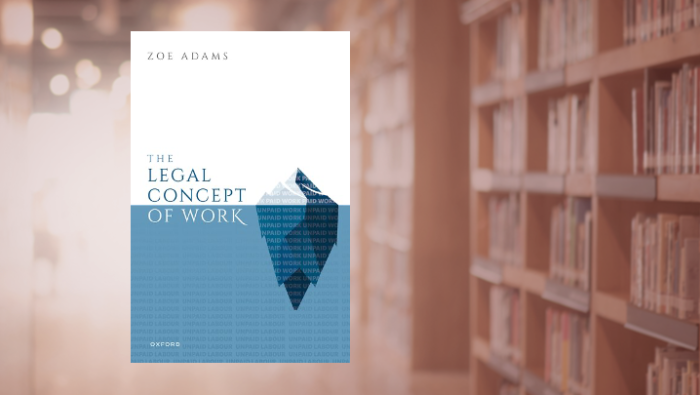
The Law’s Making of Work

In The Legal Concept of Work, Zoé Adams analyses how the law determines which forms of human labour are considered as work and which ones are not. She shows in six chapters the contingency of labour law along historical junctures when struggles over working time, renumeration, and social security occurred. Adams highlights both: law’s social imaginary and its’ image of what the world looks like on the one hand and the law’s “own role in that world, including its capacity to change it” (p. 4) on the other. The depth and precision of her study make the 360 pages a true win for any labour law and socio-legal scholar.
In the first two chapters Adams dissects how law doesn’t just react to or tame a pre-existing reality of work but it “actually participates in work’s emergence, and construction” (p. 336). The central mechanisms are the abstraction and the decontextualisation of the labour relationship. The decontextualisation translates what is “actually a structural, class-based relation of control, and dependence, in the form of a direct personal right of control and direct, personal obligations of cooperation and obedience.” (p. 37) A key tool to do so is the contract. The contract has the “ability to reconcile, however imperfectly, the freedom and equality presupposed by the market, and the inequality and subordination inherent to the wage relation that emerged from it” (p. 37). Despite the assumption of freedom and equality in both the market and the law, Adams claims the unfreedom in capitalist work relations is the inability to refuse to do wage work and the inequality is the unequal distribution of this unfreedom. The contract disguises these structures.
The second mechanism is the law’s abstraction of work from its form into time. Work thus is the time that is “subject to the employer’s contractually mediated control” (p. 36). Non-work then is time, that the employer has no access to. But that is, how Adams shows, not accurate. Because employers harness capacities and practices as work ignoring these contractual boundaries through accessing time with “legal technologies” (p. 39) like work-on-demand or zero-hour contracts but also through managerial strategies like “requiring workers to obtain (often unpaid) work experience prior to obtaining a job” (p. 33), strategic uses of occupational descriptions or ‘soft’ data driven management. Furthermore, the legal concept of non-work (the negation of work as the time subject to the employer’s control, thus time to one own) assumes non-work to be under individual control. But non-work time mostly is time to reproduce. And reproductive work is deeply collective and dependent – as a family, kin, community. So, all the work that that law ‘sees’ relies on as much additional work, that does not appear in contracts and thus remains ‘invisible’ to the law (p. 3) and devaluated through the separation of skills that become seen as “’innate’ properties of particular people or groups, while other are economically valuable skills” (p. 341).
After the conceptual work on the terms and their historical genesis, Adams guides us through different contexts to show how the law plays out in the construction of work. In chapter three, she shows with some pivotal cases how the master and servant legislation turned into today’s employment law in the UK. The fourth to sixth chapters all “explore the implications of the way in which the boundaries of the labour commodity are constructed in law” (p. 79) through divides between work / non-work and work / the worker. She investigates three cases to fathom out how the concept of work plays out in different sectors: book publishing (creative work), academic work, medical work, and retail work. The case studies show how workers construct divisions between paid and unpaid work, how the latter gets framed as ‘opportunities’, ‘self-motivated’ or ‘passion’, and how the law runs through these social beliefs.
Adams arguments force the reader to reconsider the role of labour law for social change. She admonishes us to think of it as the panacea for labour disputes. Using the law for short-term victories can have diametrical effects if they only work by legitimizing the very structures that would be necessary to dismantle to overcome the underlying causes for those social problems (p. 8). She argues along the lines of the abolitionist thinking of Critical Resistance on non-reformist reforms. Therefore, she finishes her book with a series of suggestions for reforms (regarding collective bargaining, of reconceptualizing the worker, on wage and working time regulations) that all challenge “assumptions embedded in the legal concept of work” (p. 359), can brace the worker with power to take away some of the existential power imbalance between employer and employee (p. 344) and help building momentum for making structural change possible.
Adams’ book is a must-read for anyone interested in the ontological foundations and structural implications of labour law, its historical contingency and its meaning today. She strengthens feminist work on social reproduction, Marxist legal scholarship on the legal form and exposes how the structure of law itself and the particular image of the world it embodies, explains many of the doctrinal and social problems labour law scholarship confronts.

